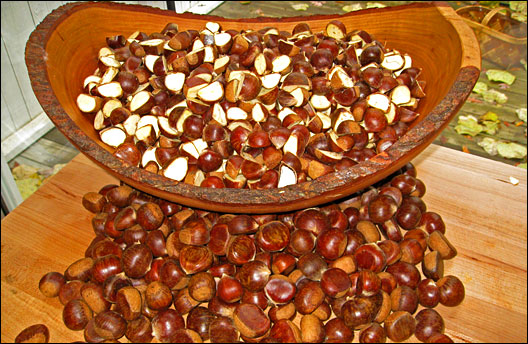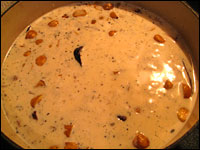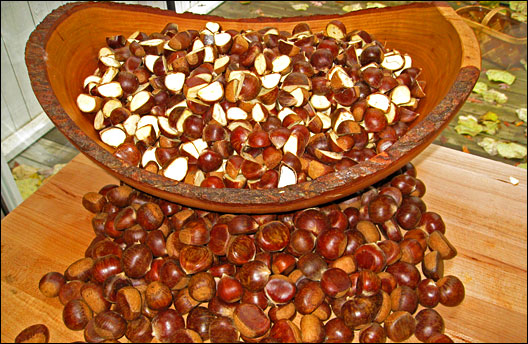
I first learned about chestnuts from “The Christmas Song” (most likely, the Chipmunks’ version), not from tasting one. That happened much later.
A couple of years ago, a farmer brought locally grown chestnuts to the back door of the restaurant where I worked. My coworkers and I were excited to see them and, of course, we wanted some. However, we had no idea what to do with them in their raw form — not one of us had ever cooked with them.
Chestnuts seemed almost exotic to us — I assumed they must be of European or Asian origin, since I had only encountered recipes and dishes made with chestnuts in cookbooks based on those regions. But a few years ago, I was with my father at a market in Asheville, North Carolina. It was mid-December and a man was standing outside selling roasted chestnuts. My Mississippi-born-and-raised father knew what they were and had a taste for them. Clearly, there was some history here that I was missing.
That Old Chestnut
It turns out that nut made famous by “The Christmas Song” isn’t exotic at all in these parts. Until the early 20th century, chestnuts were a staple food along the Eastern seaboard, and chestnut trees dominated forests. The trees were massive — up to 100 feet tall and five feet in diameter — and were the center of the rural economy of the eastern United States. It has been said that in 1900 a squirrel could have traveled from Maine to Georgia on nothing but chestnut branches. By some estimates, one in every four trees in the Appalachian Mountains was a chestnut tree.
The trees provided the soundest timber for construction, and with every mature tree producing 6,000 nuts, they delivered a key source of fodder for wildlife and livestock. Humans enjoyed them, too. They were relished for the sweet flavor that they added to breads, soups, and stews, and they were a very valuable food crop to Native Americans, who pounded them into meal.
Everything changed in the early 1900s, when a Chinese chestnut tree at the Bronx Zoo suffered blight caused by a parasitic Asian fungus. The result was only cosmetic damage. But in perhaps the greatest ecological disaster in the history of the United States, the fungus spread to the American chestnut and completely decimated the majestic native forests from Maine to Mississippi by 1950. Although old American chestnut trees can still be found on the West Coast, all that remains of them on the East Coast are stumps, old barns, and split-rail fences.
In 1983, the American Chestnut Foundation began with the goal of reestablishing the original glory of eastern chestnut forests by transferring the disease resistance of the Chinese species genetically to the American species while preserving all other characteristics of the American species.
In 2008 and 2009, the first 500 blight-resistant American chestnut trees are being planted on National Forest lands. Large-scale planting of American chestnut forests and orchards are just a few years away, and we will soon find ourselves with a tremendous abundance of chestnuts.
We are about to have to confront the very difficult economic problem of bringing a local supply and a local demand into existence simultaneously. Other than imported chestnuts, local markets are currently being supplied by small farmers, who planted Chinese or hybrid chestnut trees in order to diversify their crops. Even in that small quantity, it seems obvious to me that traditional knowledge of how to use this crop has been all but lost. I watch them sit on my local market’s shelf growing mold exactly like I watched them decay in the restaurant kitchen.
Tough Nuts to Crack
In the restaurant kitchen, it seemed that we were all waiting for someone to jump in and show us what to do. No one did, because no one knew. By the time I finally broke down and decided to wrestle with them, I had learned my first lesson: The chestnut is highly perishable and should be frozen for extended storage.
Next, I tried scoring an “X” in their tops and roasting them like I read in books, but the task was quite cumbersome. The high probability of the knife slipping while trying to make a tiny “X” on a smooth round surface had me wondering if anyone had ever actually tested this method before. I reached for the kitchen shears and snipped an “X” in the top of the chestnuts with their sharp points. When I pulled the nuts out of the oven, I noticed that the first few were far easier to peel. As the nuts cooled, the skin began to stick to them. Twenty pounds of chestnuts and a few experiments later, I think I have came up with simplest method of peeling chestnuts. Follow my instructions below, and we’ll all be ready for the huge harvests of future.
I use the chestnuts primarily for sweet dishes, so I prefer to process them into a smooth paste. I then have easy chestnut holiday baking at my fingertips. I have no need to keep the chestnuts whole if they’re going into paste, so I found simply cutting the chestnuts in half to be the easiest way to process them. Then instead of roasting them — which is delicious in its own right — I boil the chestnuts, which softens their texture so that they can be easily puréed.
The homemade version of chestnut paste is far superior to the canned, imported variety, and you will find endless uses for it. Chestnuts are known to pair well with chocolate, but I urge you to first allow the nut’s flavor to stand alone, so that you can fully appreciate its subtle complexity.
The below recipe for chestnut pudding is my very favorite dessert. The cognac, browned butter, vanilla bean, and white sweet potato amplify the chestnut flavor. Alternately, you can use the paste as a filling for crêpes or sandwich cookies; swirl it into brownies or cheesecake batter. Warm it with a little cream and use it as an ice cream topping. Add it to cake and cookie batters, to flavor truffles, or just eat it plain on toast.

Chestnut Pudding
For 6-8 servings:
1 pound white sweet potato (or substitute orange-fleshed variety)
1 cup homemade chestnut paste, recipe follows
1 cup light brown sugar
4 large eggs
1 1/2 cup half-and-half
4 tablespoons butter, browned
1/4 cup unbleached flour
1/4 cup brandy, or other brown liqueur
1 vanilla bean scraped, or 2 teaspoons of pure vanilla extract
A pinch of salt
Preheat the oven to 400 degrees F. Pick the sweet potato with a fork and roast until tender, about 1 hour. When cool enough to handle, peel the sweet potato, mash or purée it, and measure out about 3/4 cup.
Turn the oven down to 375 degrees.
In a large bowl, beat the eggs with the brown sugar and pinch of salt until well combined and the sugar is dissolved. Add the half-and-half, the mashed sweet potato, and the chestnut paste. Whisk until well combined. Fold in the flour. Melt the butter in a skillet until it begins to brown and smell toasty. Fold it into the mixture, along with the scraping of one vanilla bean or the extract. Butter a baking dish (9 x 13 or a two-quart gratin dish) and pour in the batter. Bake 30 to 35 minutes, until a knife inserted in the center comes out clean. Allow to cool for 20 minutes before serving. The pudding will fall slightly. Sprinkle it lightly with powdered sugar and serve it with lightly sweetened whipped cream.
Homemade Chestnut Paste
1 pound chestnuts, in shell
2 1/4 cups milk
1 cup water
1/4 cup sugar, optional
Pinch of salt
1 vanilla bean, split
1 teaspoon brandy, cognac, rum, or whiskey
Bring a large pot of water to a boil. With a large chef’s knife, halve each chestnut. Working with only a handful of chestnuts at a time, drop them in the boiling water and cook for 5 minutes. Using a slotted spoon, remove the chestnuts and peel off their skins while they are hot. Use latex gloves if your fingers are sensitive. Both the outer and inner husks should come off easily this way. If the inner skin is persistent, you can boil them again for a few minutes more and the skin should slip right off. After you have peeled all of the chestnuts, place them in a heavy-bottomed, non-reactive pot with the milk, water, sugar, salt, and vanilla bean. Bring the liquid to a simmer and stir to dissolve the sugar. Turn the mixture down to low, cover, and simmer until the chestnuts are boiled-potato tender. Add more milk or water if necessary.
Drain the chestnuts and reserve the milk mixture and the vanilla bean. Dump the chestnuts in the food processor and add the scrapings of the interior of the vanilla bean and the teaspoon of liqueur. Process until smooth, adding reserved liquid as necessary to produce a smooth, thick paste. Store the paste in the refrigerator for up to 2 weeks or in the freezer for longer storage.



